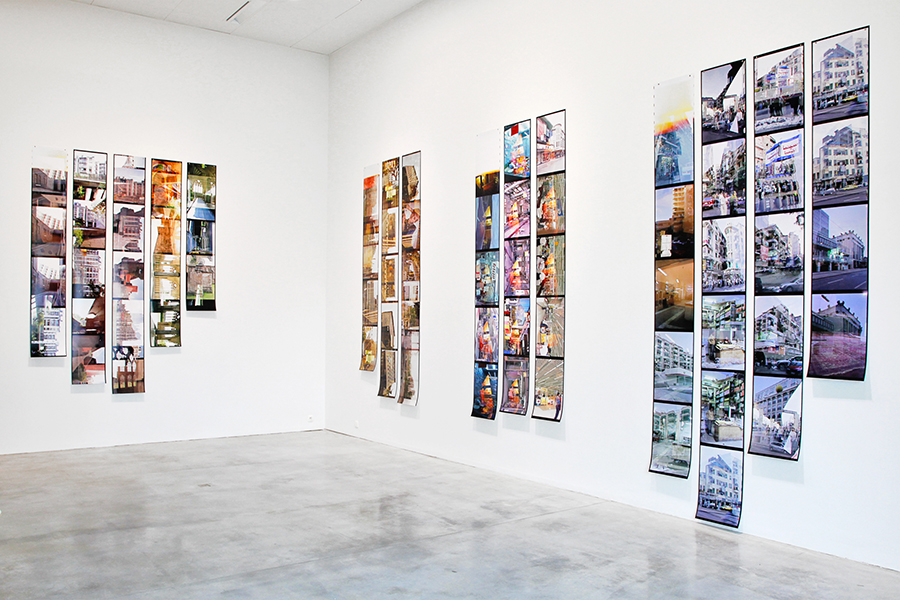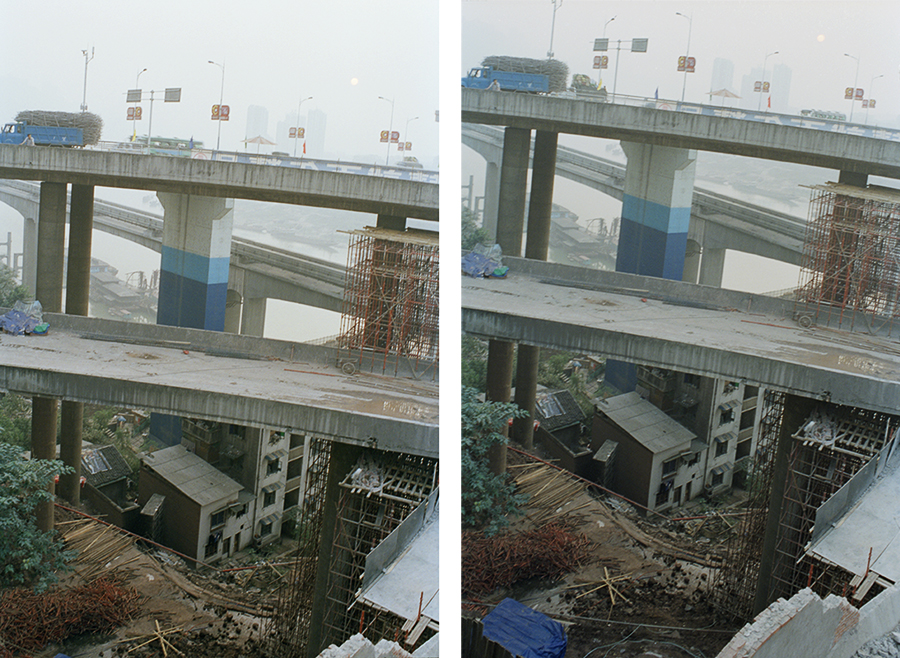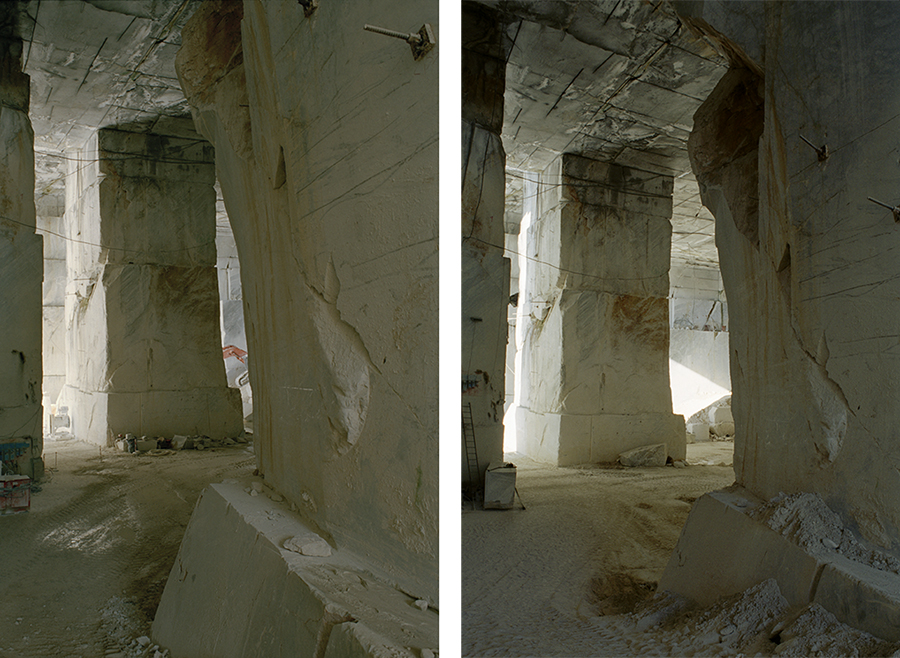En introduction à la série « Undecided Frames » d’Aglaia Konrad, série augmentée qui sera proposée à Arco Madrid 2017, ce texte de Steven Humblet extrait du dernier ouvrage d’Aglaia Konrad, « Aglaia Konrad, From A to K » (Koenig Books, 2016). L’auteur y aborde deux séries d’oeuvres qui participent de la même réflexion posée par l’artiste : Les « Zweimal belichtet » ainsi que les « Undecided Frames ».
FRAMES
By Steven Humblet
1.
Every photographer knows the drill. When taking a photograph, the first decisions that have to be made concern aiming and framing. To aim is to choose a vantage point and to decide on an orientation: high, low, left, right, frontal, oblique. Aiming is about taking up a position in a three-dimensional world, settling on the angle from which to approach the world and calculating the distance to it. While aiming involves a relationship between a multisensorial body and the world, framing puts a camera between them. Suddenly, the world is no longer palpably there, but put at a distance, turned into an image to behold.
When looking through the viewfinder the photographer is cut off, so to say, from his surroundings: his field of vision is delineated by a razor-thin edge that « cuts » a rectangular piece out of the world. As such, the act of framing comes down to deciding where the image starts, and where it ends. While determining the limits of the image, this frame is also responsible for the flattening of the world into a two-dimensional image; it organizes the visual field by putting the elements in the image in place and by articulating how they relate to each other. Thus, framing is not only an act that plays out in space, but it also unfolds in time. To frame is to test different relations to the world, to commit oneself to the subject at hand. Framing is a dynamic process wherein photographer and world feel each other up.Still, no matter how precise the preparation of the photographer, the photographic procedure is a fickle one. While taking the shot, something could always go awry: the camera jams, an image is over- or underexposed, unforeseen elements throw the carefully balanced image into disarray, etc. In photography, the moment where the image comes into being-when the shutter opens, the light enters through the lens and burns itself chemically onto the light sensitive material-is also the moment when the photographer is absent. All preceding choices and decisions inevitably end in that one, brief instance when science (the optical and chemical systems of the photographic apparatus) takes over. As Vilém Flusser notes in his “Towards a Philosophy of Photography”, the camera reveals itself here as a black box: the photographer knows the input and the output of the machine, but what happens in the deep recesses of the dark chamber remains inaccessible to him. Even if this moment generally goes unnoticed, it does reassert itself afterwards. When the photographer later on overlooks the contact sheet, he’s obliged to reaffirm the intentions, choices, and decisions made before he pressed the button. At this moment of selection, the photographer is no longer the person who takes the shot, but the one who chooses between rows of produced images. In making the editorial choice for « the right image » he re-establishes what his practice is all about: this is how he wants the subject to appear, this is the topic he wants to address, this is the kind of photography he stands for.
Seemingly disconnected from the rest of her oeuvre, Aglaia Konrad’s “Undecided Frames” (2007) and “Zweimal belichtet” (2013) address some of these often overlooked aspects of the photographic process. While these works address the built environment, they first and foremost explore some quirkier features of the photographic procedure. Remarkably enough, however, they do this by exploiting those moments when the photographic system appears to fail. As if the specificity of photography can only be glanced at when the medium stutters and stumbles.

Aglaia Konrad
Zweimal belichtet, exhibition view
2.
The series “Zweimal belichtet” incorporates several rolls of film that were accidentally used twice. These mishaps were not programmed but the result of a specific working method that accompanies the analogue process. As Konrad photographs the same subjects in black and white and in colour, and hence constantly recharges her camera with different film rolls, a mix-up may occur in which she re-uses an already exposed film roll. Only after development she noticed the mistake: two shots taken at different moments and showing different subjects are mashed together in a layered and fractured image. The film rolls that unfurl before the viewer show a continuous flow of extremely hard to read images. As different spaces and times crash into one another, with their lines, colours and forms awkwardly fused, the world is no longer recognizable but becomes a hotchpotch of fragments. The double exposures are not superimposed in a discernable hierarchy, but coalesce into an intangible mess.
Confronted with this clutter, the viewer starts to loose his bearings: his eye is unable to rest on one of the double takes, zooming in and out like an auto-focus camera. Indeed, the viewing experience is tantamount to what occurs while the photographer looks through his viewfinder: both observer and photographer seem immersed in that moment when the image is out of focus, when everything that meets the eye is in the process of becoming. But, while the ordeal of the photographer usually ends successfully, the viewer is not so lucky here: he remains stuck in this moment where everything still wavers between presence and absence
Although these images originated as failures, they are consciously recuperated as intriguing examples of an intrinsic part of the (analogical) photographic process.
Their unreadability effectively overturns normative conceptions of the photographic image and its composition, but it also explores those unforeseen visual possibilities contained within the photographic medium. Indeed, these bewildering images are testimonial to the crucial role that chance plays in the photographic act. The photographic image, as a technological and chemical process, is the consequence of a camera that « looks » indiscriminately at the world, soaking in everything what is in front of it, making no distinction between what is important and what is not. It is in the slipstream of this automatic process that chance asserts its (potentially damaging) role. It is up to the photographer then to play with chance, to strike the right balance between control and surrender, and, in fact, to use chance as that « sting of the real » which invigorates the photograph. Yet Konrad’s double impressions seem to have arisen from a picture-taking system in which chance took over. As such, they remind us of the dangerous (and therefore titillating) novelty the photographic act introduced in the visual culture of the 19th century, when, with the advent of the camera, anything could be depicted-whenever, whatever, wherever: such was the image-making credo introduced by the camera. When contingency takes the overhand and chance dominates the production of the image, the coherence the photographer is supposed to bring to the image collapses. As a result, the photographic agent is superimposed by an « other, » and perhaps more radical, image-making process, one in which the techno-scientific laws of the photographic system rule.3.
Another photographic conundrum radiates from the series “Undecided Frames”. This work consists of pairs of photographs that are juxtaposed in a frame, with only a broad white border separating them. Although the photographs look similar at first, they display competing versions of one and the same image, the barely noticeable differences between them the results of a camera that has moved ever so slightly. One photographic pair, for example, shows a construction/destruction site in Chongqing, China. In the left image, the area is frontally photographed, with the camera pointed straight ahead, while the right captures the scene with the camera slightly tilted downward. In principal, nothing has changed: the lorry is still seen standing on the upper bridge and the man-potentially the driver-is still leaning on the rail. The photographs are shot within a relatively short timeframe, yet they present a different view: one photograph looks more balanced whereas the other shows the scene in a more dynamic way, as if stressing the dialectic between the construction of the highway and the destruction of the houses. Two very different takes, then, and yet, as the title intuits, no choice could be made? In sabotaging the moment of selection, Konrad’s Undecided Frames not only highlights the absurdity of the photographic act but also muddles the relationship between the four parties involved in photography: photographer, camera, world and viewer.

Aglaia Konrad
Undecided frames (Chongqing), 2012
colors photography, 41 x 54 cm. Ed 5/5
Suggested by the title, these pairs express an impossibility to choose « the right image. » As the camera makes no mistakes-each and every technical image is a viable alternative-there is no good or bad image logically speaking: photography simply measures and captures the light refracted by whatever falls within the scope of the lens. Put differently, to say that a photographic image fails is to introduce an act of judgement, performed by a discerning subject that declares the photograph good, bad, interesting, deficient, etc. Because the mechanical nature of the medium asserts that every image is nonetheless right and also because the criteria, standards, and convictions on which aesthetic judgement is based transfigure historically- a particular form of indecisiveness that is intimately linked to the photographic act as such comes to the fore. While the photographer and the camera start as an inseparable unity, the moment the photographer presses the button this unity is violently severed, both following for a brief moment of time their own path, their own logic.
Only later on, when the image is developed and the photographer meets the result on the contact sheet, will he find himself included again in the photographic process, though now engaged in a discussion about which image to accept or reject. The photographic act installs an undecidability following directly from the action of the camera, but also, indirectly, from the discrepancy between that logic and the (mutable) set of aesthetic standards the photographer adheres to.

Aglaia Konrad
Undecided frames (Carrara), 2012
colors photography, 41 x 54 cm. Ed 5/5
Two photographs of a rectangular column of marble in the Carrara quarries illustrate another of these inherently photographic paradoxes. Reading them left to right, these images infer a slight movement backwards and to the left. But we don’t really see such a movement, we only notice a jump between two different spatial positions (with the white, in-between border acting as « dead time »). Like other pairs in the series, this photographic couple differentiates our own, phenomenological sense of being in the world from the camera’s: where we experience a spatiotemporal continuum and glide fluently from one moment/place to another, the apparatus stutters and carves up the spatiotemporal continuum into discrete, discontinuous moments/places. On another level, the differences between the double takes could also be understood as a reference to Konrad’s working method. They would express her careful exploration of the subject, a continuous probing of it with the camera, the slight changes expressing a vivid but also somewhat fuzzy negotiation with the world. However, by each time limiting herself, in a body of work titled “Undecided Frames”, to only two images, she also points out that these photographs shouldn’t be seen as alternatives for one another, but as separate images in their own right. Immediately the problem of choosing reasserts itself, albeit with a slightly different and somewhat unexpected outcome: choosing becomes impossible not because these two images look similar, but because they are incomparably different.
In refusing to choose, Konrad also reclaims her position as an intermediary between image and viewer. Bringing the differences between the two images (however small they might be) to the notice of the viewer, she makes clear that every photographic image is the result of her subjective choices. Moreover, by naming these double takes « undecided » she manoeuvres the viewer into a situation he normally never has to deal with, the moment of choosing being a solitary moment, safely hidden from the prying eyes of the public. Now the question of choosing becomes our problem: are we supposed to make the choice Konrad didn’t want to make? Maybe, but for us, this idea of choosing is even more senseless than it was for her, because we have no stake in this choice. The only option we are left with is to nod our head from left to right (and back again), searching in vain for a way out of this either/both/neither dilemma. We find ourselves forever stuck in the impossible logic of the photographic system.
4.
It is no surprise that “Zweimal belichtet” and “Undecided Frames” are intrinsically linked to the contact sheet: there Konrad encountered the technical failure and the visual promise of the double exposures, and there she experienced, given the logic of the camera, the fundamental arbitrariness of each choice. The contact sheet is the source from which every project starts, a reservoir of images that serves as an onset to explore the astonishing flexibility of the photographic image, and the medium of photography, in exhibitions, book projects, and installations. As images are not bound to any specific support and have no fixed dimensions or order-always on the move and never settling down- Konrad brazenly experiments with the material form and production method of the photographic image. One feature, however, stands out: she rarely crops or cuts into her images. Her interventions deal with the more tangible aspects of the photographic image – like its support, its dimensions, etc.- not with the more careful and balanced manipulations of light and dark in the darkroom. Konrad is not a photographer of the chemical layer, of the photographic post-production, but one of the optical system, of the lens, of the choices made during aiming and framing. Something of this reverence for the full image is visible in “Zweimal belichtet” and “Undecided Frames” as well. In the former, Konrad accepted the film rolls as such: no cuts were made and no parts were given preference to, since the film rolls are presented as a continuous whole. In the latter, the problem of choosing can only be taken serious, as the images haven’t been tampered with: her « indecisiveness » is not a mere subjective, constructed dilemma, but a problem integral to photography itself.
Steven Humblet teaches theory and history of photography at LUCA School of Arts, Brussels. He has studied philosophy and anthropology, wrote a dissertation on Benerice Abbott’s “Changing New York”, and publishes regularly on photography.
[sociallinkz]